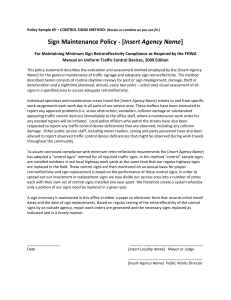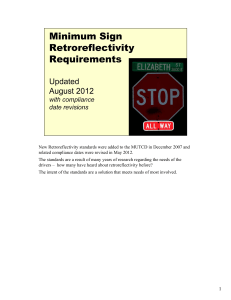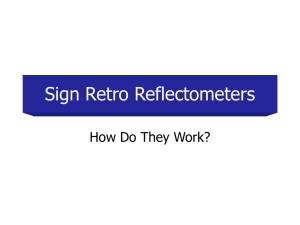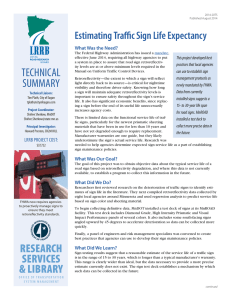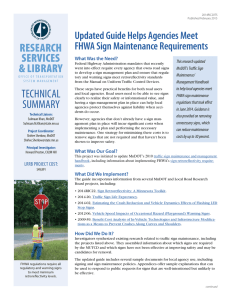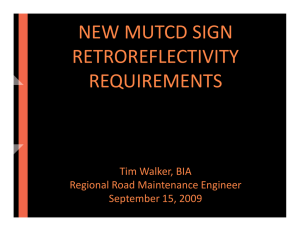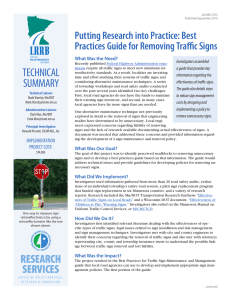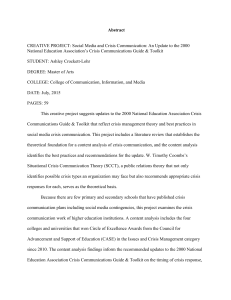TECHNICAL SUMMARY Putting Research into Practice: Establishing a Sign Retroreflectivity
advertisement
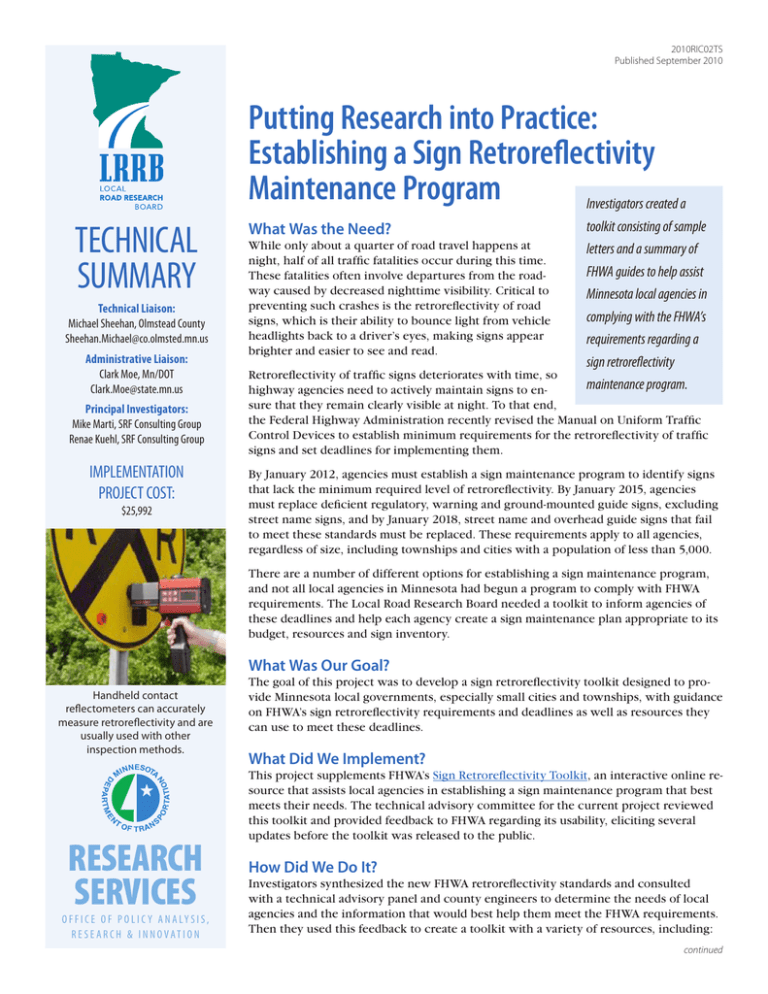
2010RIC02TS Published September 2010 Putting Research into Practice: Establishing a Sign Retroreflectivity Maintenance Program Investigators created a TECHNICAL SUMMARY Technical Liaison: Michael Sheehan, Olmstead County Sheehan.Michael@co.olmsted.mn.us Administrative Liaison: Clark Moe, Mn/DOT Clark.Moe@state.mn.us Principal Investigators: Mike Marti, SRF Consulting Group Renae Kuehl, SRF Consulting Group IMPLEMENTATION PROJECT COST: $25,992 What Was the Need? While only about a quarter of road travel happens at night, half of all traffic fatalities occur during this time. These fatalities often involve departures from the roadway caused by decreased nighttime visibility. Critical to preventing such crashes is the retroreflectivity of road signs, which is their ability to bounce light from vehicle headlights back to a driver’s eyes, making signs appear brighter and easier to see and read. toolkit consisting of sample letters and a summary of FHWA guides to help assist Minnesota local agencies in complying with the FHWA’s requirements regarding a sign retroreflectivity maintenance program. Retroreflectivity of traffic signs deteriorates with time, so highway agencies need to actively maintain signs to ensure that they remain clearly visible at night. To that end, the Federal Highway Administration recently revised the Manual on Uniform Traffic Control Devices to establish minimum requirements for the retroreflectivity of traffic signs and set deadlines for implementing them. By January 2012, agencies must establish a sign maintenance program to identify signs that lack the minimum required level of retroreflectivity. By January 2015, agencies must replace deficient regulatory, warning and ground-mounted guide signs, excluding street name signs, and by January 2018, street name and overhead guide signs that fail to meet these standards must be replaced. These requirements apply to all agencies, regardless of size, including townships and cities with a population of less than 5,000. There are a number of different options for establishing a sign maintenance program, and not all local agencies in Minnesota had begun a program to comply with FHWA requirements. The Local Road Research Board needed a toolkit to inform agencies of these deadlines and help each agency create a sign maintenance plan appropriate to its budget, resources and sign inventory. What Was Our Goal? Handheld contact reflectometers can accurately measure retroreflectivity and are usually used with other inspection methods. RESEARCH SERVICES O F F I C E O F P O L I C Y A N A LY S I S , R E SE A R C H & I N N OVAT I O N The goal of this project was to develop a sign retroreflectivity toolkit designed to provide Minnesota local governments, especially small cities and townships, with guidance on FHWA’s sign retroreflectivity requirements and deadlines as well as resources they can use to meet these deadlines. What Did We Implement? This project supplements FHWA’s Sign Retroreflectivity Toolkit, an interactive online resource that assists local agencies in establishing a sign maintenance program that best meets their needs. The technical advisory committee for the current project reviewed this toolkit and provided feedback to FHWA regarding its usability, eliciting several updates before the toolkit was released to the public. How Did We Do It? Investigators synthesized the new FHWA retroreflectivity standards and consulted with a technical advisory panel and county engineers to determine the needs of local agencies and the information that would best help them meet the FHWA requirements. Then they used this feedback to create a toolkit with a variety of resources, including: continued “This toolkit will make the process of complying with FHWA’s retroreflectivity requirements simpler and easier to understand for local agencies.” –Renae Kuehl, Associate, SRF Consulting Group “Because local agencies have limited budgets and varying circumstances, it’s important that they be given all the available options for customizing a sign maintenance program to meet their specific needs.” Control signs involve monitoring the performance of a sample set of signs that are representative of a part of an agency’s inventory. When the retroreflectivity levels of these signs approaches minimum levels, agencies replace all signs in the field associated with these control signs. • Communication materials to be sent by county engineers to small local agencies within their county to notify them of retroreflectivity requirements and resources and then to follow up to stress the importance of addressing these requirements. • A MN MUTCD Requirements document summarizing official minimum retroreflectivity requirements in Minnesota. • A summary of relevant FHWA guides, including Methods for Maintaining Traffic Sign Retroreflectivity and appendices in Know Your Retro 2007 detailing methods for assessing and managing sign retroreflectivity. What Was the Impact? This project produced a promising toolkit for helping Minnesota local agencies to meet these retroreflectivity standards cost-effectively and within FHWA’s deadlines. Options for sign management described in the toolkit include: • Visual nighttime inspection by a trained sign inspector. • Measurement using a retroreflectometer. –Michael Sheehan, Olmsted County Engineer • Expected sign life, based on past experience, of sign retroreflectivity degradation in a given geographic area. • Blanket replacement, in which all signs within a given area are replaced at specified intervals. • Control signs, in which signs are replaced based on the performance of a sample of control signs. The Minnesota toolkit includes a one-page summary of procedures for each of these methods, and also includes examples of sign inventory and management plans. What’s Next? Produced by CTC & Associates for: Minnesota Department of Transportation Research Services Section MS 330, First Floor 395 John Ireland Blvd. St. Paul, MN 55155-1899 (651) 366-3780 www.research.dot.state.mn.us City and county engineers have been informed of the online availability of this toolkit by email; they can now use the provided letter templates to inform other agencies within their communities. Investigators have presented this information at several conferences and plan to conduct further presentations in the future. By adequately maintaining the retroreflectivity of signs, agencies can help improve highway safety and prevent roadway crashes. This Technical Summary pertains to the LRRB-produced Report 2010RIC02, “Sign Retroreflectivity: A Minnesota Toolkit,” published March 2010. The full report can be accessed at http://www.lrrb.org/PDF/2010RIC02.pdf. The information being implemented via this project can be found in the FHWA’s “Sign Retroreflectivity Toolkit” at http://safety.fhwa.dot.gov/roadway_dept/night_visib/retrotoolkit.
